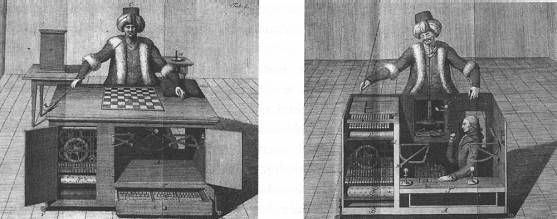|
|
Johann Nepomuk Mälzel (August 15, 1772 - July 21, 1838) was an inventor, engineer, and showman, best known for manufacturing a metronome and several music automatons, and displaying a fraudulent chess machine.
Mälzel was born in Regensburg (Germany) as the son of an organ builder. He received a comprehensive musical education and moved to Vienna in 1792. There he invented the panharmonicon, an automaton able to play the musical instruments of a military band, powered by bellows and directed by revolving cylinders storing the notes. In 1813 he met Beethoven and convinced him to write a piece for the panharmonicon, "Wellington's Victory" (Op. 91). Rewritten for orchestra, it was first performed in 1813 and later caused a bitter conflict between the two men, when Mälzel claimed ownership of the piece and Beethoven sued. Earlier, Mälzel had constructed several ear trumpets to help Beethoven with his hearing.
Mälzel also constructed a trumpet automaton and a speaking doll with moving eyes.
In 1816, Mälzel constructed and patented a portable metronome, to this day known as Mälzel's Metronome (MM). The metronome had been invented earlier by Dietrich Nikolaus Winkel, and Mälzel used several of Winkel's construction ideas.
Wolfgang von Kempelen had constructed a chess machine in 1769. It consisted of a chess table and a mechanical life-size puppet dressed as a Turk (which gave the machine its name) sitting behind the table. The puppet mechanically moved the chess pieces. Under the table an elaborate mechanism could be shown to the public; behind that mechanism a small chess player was hidden. Von Kempelen went on tour with the Turk, attracting much attention. Early on, several writers suspected a hidden human player, but others philosophized about the implications of the mechanization of intelligence.
 |
von Kempelen's Chess Turk |
After von Kempelen's death in 1804, Mälzel acquired the machine from von Kempelen's son, and again went on tour with it. At that time, the hidden chess player was William Lewis. In 1825 the British mathematician Robert Willies wrote a study, detailing how a chess player could hide below the table.
In the same year, Mälzel left Europe for New York and exhibited the Turk on the East Coast of the United States, leading again to several newspapers reports. He modified the machine so that it could also play Whist. Already after a few months, several clones of the machine were being exhibited by others.
But then two youths in Baltimore oversaw how the chess player Wilhelm Schlumberger climbed out of the Turk, leading to articles in the Baltimore Gazette explaining the fraud. Edgar Allan Poe, apparently unaware of this article, wrote another analysis of the machine, attempting to expose the fraud. It was titled Maelzel's Chess Player and published in 1836.
Schlumberger later died of the yellow fever, Mälzel started to drink and died of an alcohol overdose on a ship in the harbor of La Guaira, Venezuela.
The Turk was destroyed in 1854 during a museum fire in Philadelphia.
External links
- Maelzel's Chess Player (http://www.eapoe.org/works/essays/maelzel.htm) by Edgar Allan Poe
"Maelzel died on a tour of America. The brig he was on, the Otis, went down on its way from Havana to Philadelphia. Maelzel - and his Panharmonicon - went down with it." - MadAboutBeethoven.com (http://www.madaboutbeethoven.com/pages/people_and_places/people_friends/biog_maelzel.htm)
